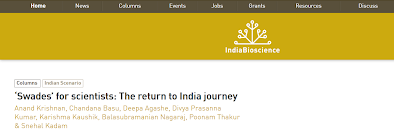Returning to India and setting up independent groups is a long-cherished dream of many Indian scientists who have been working and living abroad, and are looking forward towards undertaking professional transition to India for pursuing their research interests in biosciences and other related research areas.
While multiple Re-entry fellowships are available for Indian scientists and engineers from abroad, who are seeking scientific positions in the Indian institutes, each of these fellowships comes with specific eligibility and are very selective. This article is based on panel discussions and Sci-ROI webinars on the re-entry fellowships. It compares and summarizes three different funding schemes conceptualized by various S&T agencies of the Government of India. These funding schemes are aimed to attract highly skilled researchers of Indian nationality working overseas in cutting-edge disciplines of life sciences and all other allied areas by providing them an attractive research avenue.
The awardees of this senior fellowship scheme, for which candidates (Indian nationals) working only in the overseas institutions are to be considered, are posted equivalent to an Assistant Professor/Scientist-D level officer, and entitled to take up teaching or research assignments and mentoring doctoral/MS students.
The detailed information on the eligibility and nature of the fellowship is available in the official website of Department of Biotechnology (https://dbtindia.gov.in/schemes-programmes/building-capacities/building-critical-mass-science-leaders/ramalingaswami-re). Here, we focus on some of the important takeaways from the Sci-ROI Grant Writing webinar on Ramalingaswami Re-entry Fellowship, which included a panel discussion with successful grant applicants who represented their host institutes and the DBT. This document should serve as a repository of information for NRI young investigators (who are looking to return to India) on the transition process and the Indian scientific ecosystem.
Although around 55% of the applicants have been adsorbed as faculties through these fellowship schemes in 2018-2019, the overall percentage has gradually decreased since 2013-14.
This Fellowship is offered by Science and Engineering Research Board (SERB) (https://www.serbonline.in/SERB/Ramanujan_fellowship?HomePage=New). The SERB recommends that a Ramanujan fellow is equivalent to Scientist-D.
INSPIRE Faculty Fellowship provides an opportunity to post-doctoral researchers for carrying out independent research however does not guarantee a regular position after 5 years.
Unlike the Ramanujan or Ramalingaswami Re-entry fellowships, The INSPIRE Faculty Fellowship is not exclusively available to NRI researchers as Indian citizens and people of Indian origin with a STEM Ph.D. degree from any recognized university worldwide are eligible for this fellowship.



Written by
Arindam Naha
Postdoctoral Fellow,
The University of Texas Health Science Center at Houston (UTHealth)
Edited by
C M Santhosh Kumar
Research Fellow, University of Birmingham
Kamal Malhotra
Postdoctoral Fellow, University of Ottawa Heart Institute